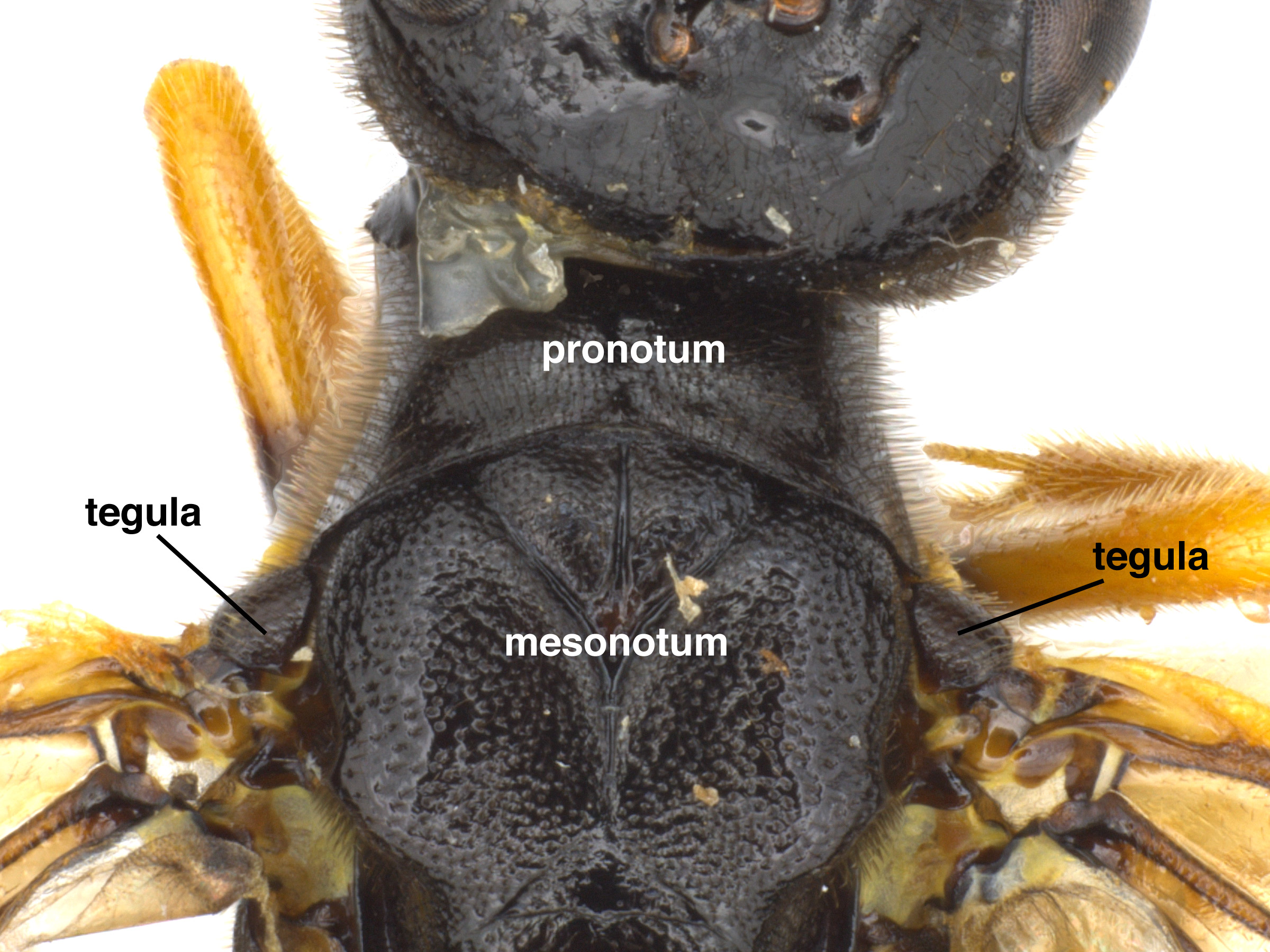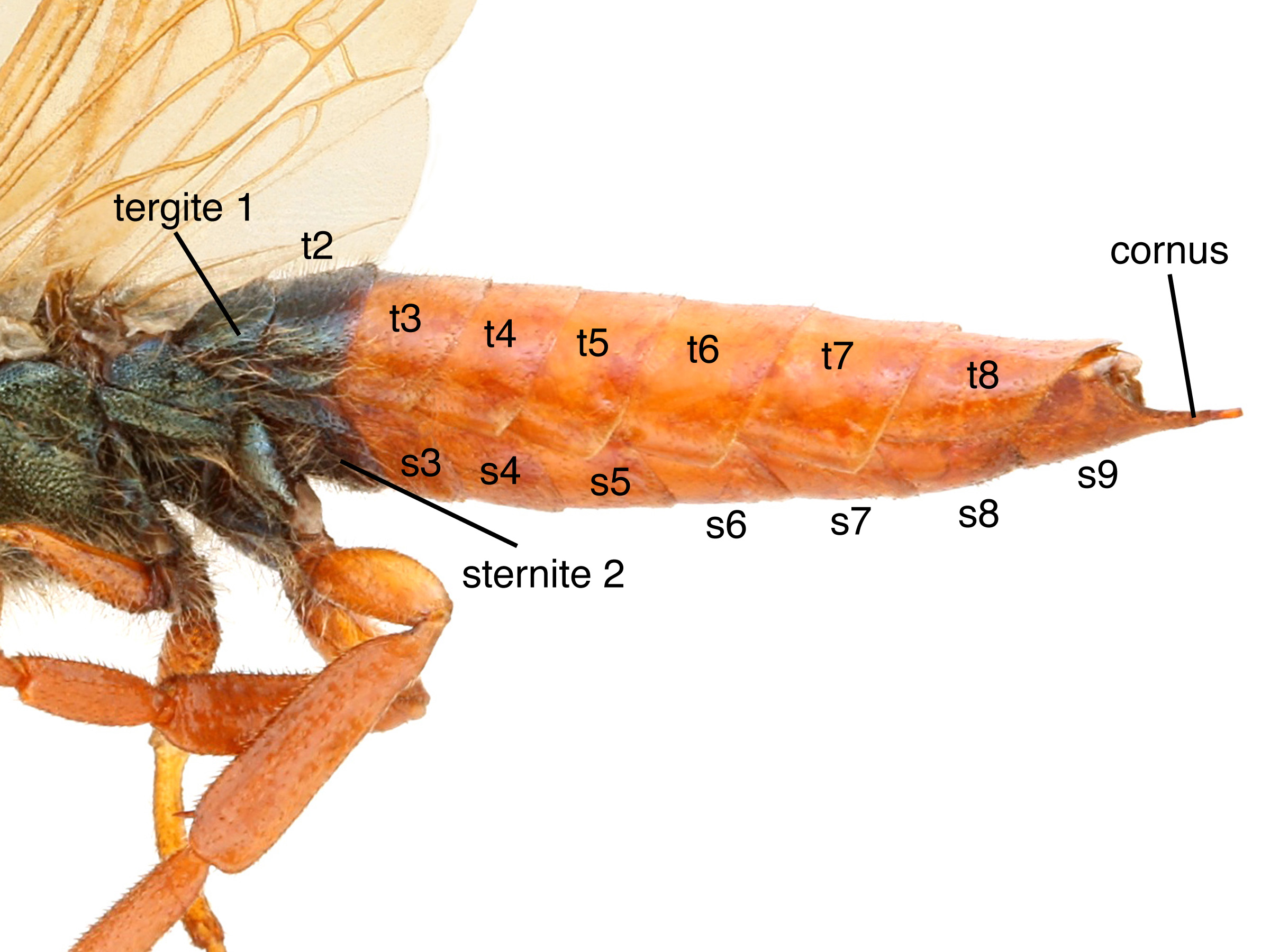Superfamily: Orussoidea
Family: Orussidae
Family common name: parasitic wood wasps
Subfamilies: Ophrynopinae, Orussinae
Orussidae is a rarely collected family with some unique forms and behaviors (Vilhelmsen 2004Vilhelmsen 2004:
Vilhelmsen L. 2004. The old wasp and the tree: fossils, phylogeny, and biogeography in the Orussidae (Insecta, Hymenoptera). Biological Journal of the Linnaen Society 82: 139-160.). The larvaelarva:
the immature stage of holometabolous insects
 are parasitic and feed on wood-boring beetle larvaelarva:
are parasitic and feed on wood-boring beetle larvaelarva:
the immature stage of holometabolous insects
 . Adults are easily recognized by the low insertion of the antennaeantenna:
. Adults are easily recognized by the low insertion of the antennaeantenna:
the sensory organ emerging from the front of the head, usually between the compound eyes and above the clypeus; includes the flagellum, scape and pedicel
 on the face, truncatetruncate:
on the face, truncatetruncate:
ending abruptly; cut off squarely; opposite of tapering
apicalapical:
towards the apex; farthest away from the body
antennal segments, and the reduced wing venationvenation:
the network of veins on a wing
(Middlekauff 1983Middlekauff 1983:
Middlekauff WW. 1983. A revision of the sawfly family Orussidae for North and Central America (Hymenoptera: Symphyta, Orussidae). University of California Publications in Entomology 101: 1-46.).
Orussidae includes 18 genera and 88 species worldwide. About 4 genera and 12 species are NearcticNearctic:
describing the region of the Northern Hemisphere that includes North America south through northern Mexico
 in distribution (Taeger et al. 2018Taeger et al. 2018:
in distribution (Taeger et al. 2018Taeger et al. 2018:
Taeger A, Liston AD, Prous M, Groll EK, Gehroldt T, and Blank SM. 2018. ECatSymmdash;Electronic World Catalog of Symphyta (Insecta, Hymenoptera). Program version 5.0 (19 Dec 2018), data version 40 (23 Sep 2018). Senckenberg Deutsches Entomologisches Institut (SDEI), Muuml;ncheberg. https://sdei.de/ecatsym/ Accessed: 28 Jan 2020.).
Kulcania
Ophrynon
Ophrynopus
Orussus
 evenly sloped; not extremely constricted medially (Goulet 1992Goulet 1992:
evenly sloped; not extremely constricted medially (Goulet 1992Goulet 1992: short ventrally (Goulet 1992Goulet 1992:
short ventrally (Goulet 1992Goulet 1992: not divided medially (Goulet 1992Goulet 1992:
not divided medially (Goulet 1992Goulet 1992: with a stub-like apicalapical:
with a stub-like apicalapical: with 10 segments, male with 11 segments (Middlekauff 1983Middlekauff 1983:
with 10 segments, male with 11 segments (Middlekauff 1983Middlekauff 1983:In North America, Orussidae feeds on species of beetle in the family Buprestidae (Goulet 1992Goulet 1992:
Goulet H. 1992. The genera and subgenera of the sawflies of Canada and Alaska: Hymenoptera. Symphyta. The insects and arachnids of Canada. Part 20. Agriculture Canada Publication.).
Orussidae can be distinguished from other families by the antennal insertion location lower than the compound eye (Goulet 1992Goulet 1992:
Goulet H. 1992. The genera and subgenera of the sawflies of Canada and Alaska: Hymenoptera. Symphyta. The insects and arachnids of Canada. Part 20. Agriculture Canada Publication.).
Orussidae sawflies oviposit into larvaelarva:
the immature stage of holometabolous insects
 of wood-boring beetles, through the bark of the host tree. The sawfly larvalarva:
of wood-boring beetles, through the bark of the host tree. The sawfly larvalarva:
the immature stage of holometabolous insects
 feeds on the developing beetle larvalarva:
feeds on the developing beetle larvalarva:
the immature stage of holometabolous insects
 and then pupates and emerges from the tree (Middlekauff 1983Middlekauff 1983:
and then pupates and emerges from the tree (Middlekauff 1983Middlekauff 1983:
Middlekauff WW. 1983. A revision of the sawfly family Orussidae for North and Central America (Hymenoptera: Symphyta, Orussidae). University of California Publications in Entomology 101: 1-46.).
World: This family is most diverse in the Southern Hemisphere, in tropical Africa, Madagascar, Southeast Asia, the Philippines, New Guinea, Australia, and tropical South America, but is also found in North America, Europe, and Japan (Middlekauff 1983Middlekauff 1983:
Middlekauff WW. 1983. A revision of the sawfly family Orussidae for North and Central America (Hymenoptera: Symphyta, Orussidae). University of California Publications in Entomology 101: 1-46., Vilhelmsen 2004Vilhelmsen 2004:
Vilhelmsen L. 2004. The old wasp and the tree: fossils, phylogeny, and biogeography in the Orussidae (Insecta, Hymenoptera). Biological Journal of the Linnaen Society 82: 139-160.).
North America: Orussidae occurs throughout the United States and into southern Canada, south into Mexico, Central America, and the Caribbean Islands (Middlekauff 1983Middlekauff 1983:
Middlekauff WW. 1983. A revision of the sawfly family Orussidae for North and Central America (Hymenoptera: Symphyta, Orussidae). University of California Publications in Entomology 101: 1-46.).